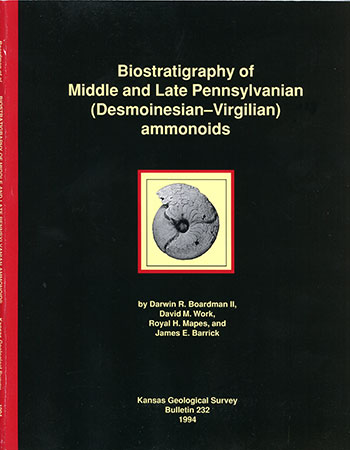
Kansas Geological Survey, Bulletin 232, originally published in 1994

Originally published in 1994 as Kansas Geological Survey Bulletin 232. This is, in general, the original text as published. The information has not been updated.
New stratigraphic ranges for genera of Desmoinesian-Virgilian ammonoids are presented, based on analysis of 40,000 specimens collected from over 70 ammonoid-bearing horizons that represent at least 40 successive stratigraphic levels in the North American midcontinent. These range revisions indicate that current generic-level ammonoid zonations are inadequate, especially for correlation of Pennsylvanian series and stage boundaries. Six high-confidence, largely generic-level first-occurrence zones are proposed for the Desmoinesian through Virgilian stages: Wellerites Zone, Eothalassoceras Zone, Pennoceras Zone, Preshumardites Zone, Pseudaktubites Zone, and Shumardites Zone. Fifteen zones of lesser confidence for correlation are also suggested.
The Shumarditidae Plummer & Scott, 1937, is emended to include Preshumardites Plummer & Scott, 1937, Pseudaktubites gen. nov. (type species, Preshumardites stainbrooki Plummer & Scott, 1937), and Shumardites Smith, 1903. Early Permian (Sakmarian) species previously assigned to Preshumardites are reassigned to Andrianovia gen. nov. (type species ?Preshumardites sakmarae Ruzhencev, 1938). Aktubites Ruzhencev, 1955, Eoshumardites Popov, 1960, and Parashumardites Ruzhencev, 1939, previously included in the Shumarditidae, are assigned to the new family Parashumarditidae. Eovidrioceras inexpectans gen. nov., sp. nov. is included and is interpreted as the ancestor of the cyclobacean family Vidrioceratidae Plummer & Scott, 1937.
The base of the revised Wellerites Zone, defined by the first occurrence of the nominate genus, approximates but does not coincide with the Atokan-Desmoinesian boundary. Recorrelation of the stratigraphic level of the Collinsville, Oklahoma, ammonoid locality from the "Seminole Formation" (basal Missourian) to the Holdenville Formation (upper Desmoinesian), based on lithostratigraphic evidence, effectively places the first occurrence of Eothalassoceras in the upper Desmoinesian. Because Wellerites apparently became extinct before the end of the Desmoinesian, the revised Eothalassoceras Zone is used to represent the upper Desmoinesian.
The Middle-Upper Pennsylvanian boundary (Desmoinesian-Missourian boundary) can be recognized by the appearance of Pennoceras, which defines the base of the new Pennoceras Zone. The Pennoceras Zone is an excellent indicator of lower Missourian strata in the northern midcontinent, north-central Texas, the Marathon Uplift, and the Appalachian Basin. The new Preshumardites Zone occupies most of the upper part of the Missourian Stage.
The appearance of the ancestral shumarditid Pseudaktubites, which defines the base of the new Pseudaktubites Zone, occurs one cycle below the Missourian-Virgilian boundary, which is currently recognized at the top of the South Bend Limestone Member in eastern Kansas. No recognizable biostratigraphic event coincides with the South Bend Member, thereby resulting in an uncorrelatable chronostratigraphic boundary. The largest changeover in ammonoid faunas takes place at the base of strata containing the upper part of the Pseudaktubites Zone (Pseudaktubites stainbrooki Subzone). The base of the Pseudaktubites stainbrooki Subzone is stratigraphically near the original Missourian-Virgilian boundary. It is recommended that the stratigraphic level containing the base of the Pseudaktubites stainbrooki Subzone be adopted as the official base of the Virgilian Stage. Recognition of the upper subzone of the Pseudaktubites Zone (Pseudaktubites stainbrooki Subzone) within the Colony Creek Shale Member in north-central Texas places the base of the Virgilian within the upper part of the Canyon Group and substantially below the current position at the Canyon-Cisco group boundary. Shumardites, a taxon previously used to mark the base of the Virgilian Stage, appears in early middle Virgilian strata; consequently, the revised Shumardites Zone represents the middle-upper Virgilian interval.
Kansas Geological Survey
Placed on web Dec. 4, 2018; originally published in 1994.
Comments to webadmin@kgs.ku.edu
The URL for this page is http://www.kgs.ku.edu/Publications/Bulletins/232/index.html